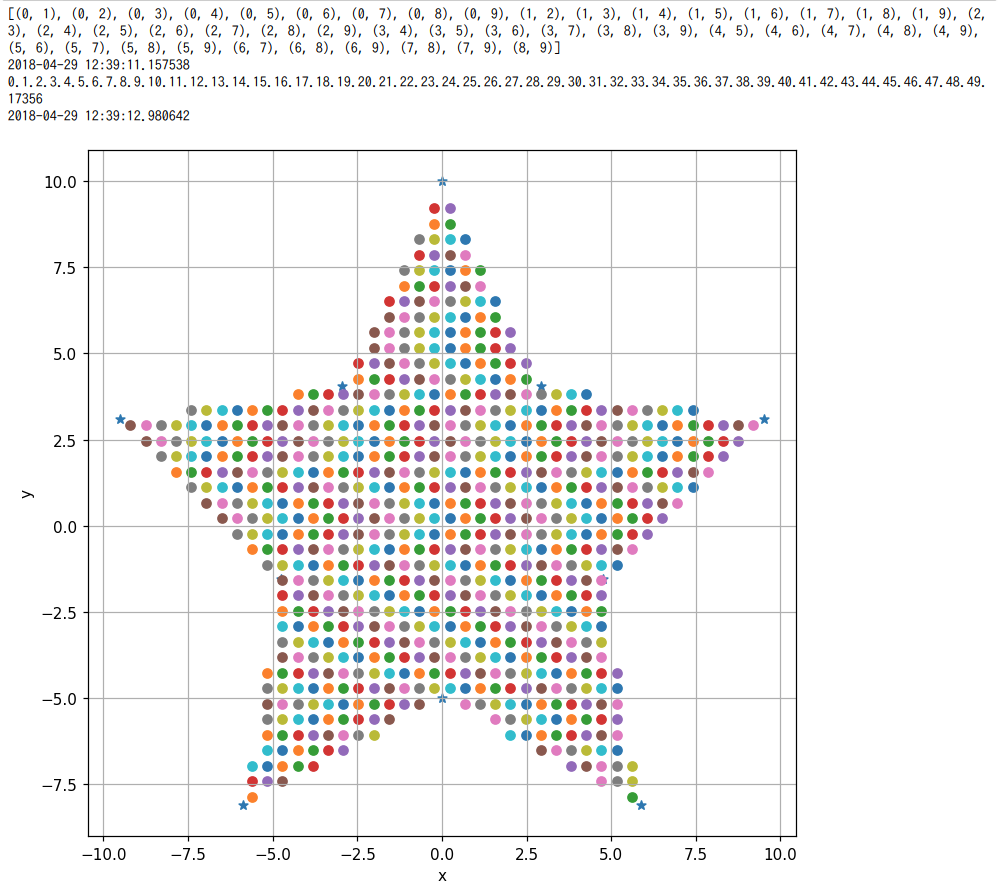動作環境
GeForce GTX 1070 (8GB)
ASRock Z170M Pro4S [Intel Z170chipset]
Ubuntu 16.04.4 LTS desktop amd64
TensorFlow v1.7.0
cuDNN v5.1 for Linux
CUDA v8.0
Python 3.5.2
IPython 6.0.0 -- An enhanced Interactive Python.
gcc (Ubuntu 5.4.0-6ubuntu1~16.04.4) 5.4.0 20160609
GNU bash, version 4.3.48(1)-release (x86_64-pc-linux-gnu)
scipy v0.19.1
geopandas v0.3.0
MATLAB R2017b (Home Edition)
ADDA v.1.3b6
gnustep-gui-runtime v0.24.0-3.1
PyMieScatt v1.7.0
Gaussian random sphereの形状情報をもとにADDAで光散乱数値シミュレーションを行うには、dipoleでfillした形状に変換する必要がある。
星形をもとに方法を検討してきた。
処理方法
下記としてみた。
- 格子状のdipoleを用意する
- 中心からdipoleの線分を検討する。
- 線分が形状の線分と交差しているか
- 交差あり: 外側
- 交差なし: 内側
内側のdipoleだけを残すことで、形状をdipoleでfillした状態になる。
code v0.2
前回の処理(sympy使用)ではMESH_RESOL=20に対して3分かかる。
遅い。
sympyのintersectionチェックは自分が使う機能以上に処理をしているように思われる (線分同士の交差だけでなく、線分と多角形の交差など)。
もっと軽量な処理を探してみた。
shapelyを使った実装例を以下に見つけた。
https://rosettacode.org/wiki/Find_the_intersection_of_two_lines#Python
使ってみた。
findDipolesInisideStarShape_180429.ipynb
%matplotlib inline
import numpy as np
import sys
import matplotlib.pyplot as plt
from pylab import rcParams
from itertools import combinations
import geometry_starShaped_180428 as GSS
import datetime as dt
from shapely.geometry import LineString
'''
v0.2 Apr. 29, 2018
- use shapely instead of sympy
v0.1 Apr. 29, 2018
- use algorithm to check inside/outside the given shape
+ segment (from center to dipole and segment of the shape
+ crossing segments indicates dipole is located outside the shape
=== branched from [find_rayCrossing_starShapedEged_180417.ipynb] ===
v0.5 Apr. 29, 2018
- loop through [theta_deg]
- add get_linesegment()
- add calc_raylinegeometry()
v0.4 Apr. 29, 2018
- find crossing point instead of crossing edge
+ remove: import [geometry_lineintersect_180415]
+ import sympy
v0.3 Apr. 28, 2018
- import geometry_starShaped_180428 (v0.3)
v0.2 Apr. 28, 2018
- exclude vertices pairs not included in the output from [geometry_starShaped_180428]
- import geometry_starShaped_180428 (v0.2)
- remove: import geometry_starShaped_180415
v0.1 Apr. 17, 2018
- check the crossing
+ import [geometry_lineintersect_180415]
- define the ray from the center
+ draw the ray
+ add [xs_ray], [ys_ray]
+ add [theta_deg]
- add idxs_seq[], combs[]
- import [combinations]
- branched from [geometry_starShaped_180414.ipynb]
'''
rcParams['figure.figsize'] = 14, 7
rcParams['figure.dpi'] = 110
def calc_raylinegeometry(theta_deg):
# define the ray from the center
radius = RAD_OUTER * 1.1 # 1.1 to cross the outmost edge
xs_ray, ys_ray = [0.0], [0.0] # center
xs_ray += [radius * np.cos(np.deg2rad(theta_deg))] # outmost
ys_ray += [radius * np.sin(np.deg2rad(theta_deg))] # outmost
return xs_ray, ys_ray
def get_linesegment(xs, ys, idx0, idx1):
pa1 = sp.Point(xs[idx0], ys[idx0])
pa2 = sp.Point(xs[idx1], ys[idx1])
return sp.Segment(pa1, pa2)
MESH_RESOL = 50
inx = np.linspace(-11, 11, MESH_RESOL, endpoint=True)
iny = np.linspace(-11, 11, MESH_RESOL, endpoint=True)
mx, my = np.meshgrid(inx, iny)
# 1. obtain star shaped points
RAD_INNER = 5
RAD_OUTER = 10
xs_str, ys_str, edgeidx = GSS.get_starShaped(RAD_INNER, RAD_OUTER)
# 2. obtain combinations of points
idxs_seq = range(len(xs_str)) # sequential indices to obtain combinations
combs = [] # combinations to obtain all the edges
for acomb in combinations(idxs_seq, 2):
combs += [acomb]
print(combs)
fig = plt.figure()
ax1 = fig.add_subplot(1, 2, 1)
ax1.scatter(xs_str, ys_str, marker='*')
ax1.set_xlabel('x')
ax1.set_ylabel('y')
ax1.grid(True)
print(dt.datetime.now())
cnt = 0 # counter to know the number of intersection check
for idx in range(len(mx)):
print(idx, end='.')
for idy in range(len(my)):
# segment from center to dipole
a1 = np.array([0.0, 0.0])
a2 = np.array([mx[idx][idy], my[idx][idy]])
sga = LineString([(a1[0], a1[1]), (a2[0], a2[1])])
# edge of the shape
isinside = True
for aidx in combs:
if not isinside:
continue
if list(aidx) not in edgeidx:
continue
cnt += 1
b1 = np.array([xs_str[aidx[0]], ys_str[aidx[0]]])
b2 = np.array([xs_str[aidx[1]], ys_str[aidx[1]]])
sgb = LineString([(b1[0], b1[1]), (b2[0], b2[1])])
if sga.intersection(sgb):
isinside = False
continue
if isinside:
ax1.scatter(mx[idx][idy], my[idx][idy])
print(cnt)
print(dt.datetime.now())
fig.tight_layout()
MESH_RESOL = 50でも1秒で処理できるようになった。
TODO
calc_raylinegeometry()使っていない。削除してもいい。
